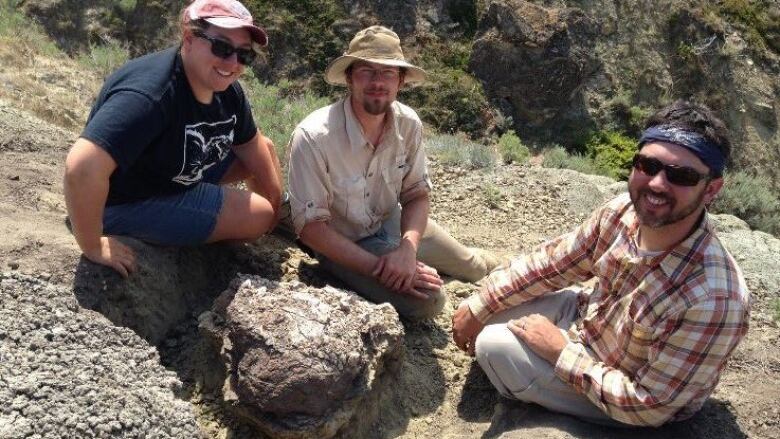Toronto researchers uncover 'nicest specimen' of armoured dinosaur species in Southern Alberta
Royal Ontario Museum paleontologists discovered an Euoplocephalus skull on Sunday

Scientists from Toronto's Royal Ontario Museum were chipping away at rock on Sunday when they uncovered a 76-million-year-old armoured dinosaur skull or ankylosaur species a find paleontologists say is unusual for this region of Southern Alberta.
"It's one of the nicest specimens of this particular type of dinosaur that we've found down here,"Victoria Arbour, paleontologist and postdoctoral fellow at the Royal Ontario Museum (ROM) and University of Toronto, told CBC Toronto.

The skull belongs to Euoplocephalus one of the largest plant-eating armoured dinosaurs in Canada.
The discovery was made by a crew digging in the prairies near Manyberries, Alta., a hamlet located 370 kilometres southeast of Calgary, Alta., near the U.S. border.
The team of researchers are on a month-long dig called the Southern Alberta Dinosaur Project -- an annual field school of paleontologists from the ROM and the Cleveland Museum of Natural History in Ohio -- that Arbour explains is "exploring some of the less well-known dinosaur baring rocks"in the region.
- New species of dinosaur found in Alberta Badlands named Hannah for now
- World's best-preserved armoured dinosaur revealed in all its bumpy glory
- This newly discovered armoured dinosaur had to hide from bigger, meaner dinos
While Euoplocephalus has been found throughout Dinosaur Provincial Park, in the heart of Alberta's Badlands, Arbour says scientists "don't actually have good fossils of it down in Southern Alberta."
"Finding specimens like this really helps us understand how dinosaurs were distributed across Alberta, so it's kind of like what their home ranges were like and what time periods we were able to find them in,"she said.
"It really helps us flesh out the ecosystems of the time in this area."
ROM scientists named new dinosaur Zuul

Arbour and David Evans, curator of vertebrate paleontology and head of dinosaur research at the ROM, were responsible for discovering a new species of armoured dinosaur in May.
The pair identified a massive rhinoceros-sized armoured dinosaur skull, which they namedZuulcrurivastatorbecause of its striking resemblance to the demon-monster in the originalGhostbustersmovie in northern Montana.
Skull is part of the bigger picture
Although she co-authored the report, Arbour says this was the first time she had unearthed an ankylosaur skull in the field, despite researching the dinosaur for a decade.
"We were all super excited to find it,"she said. "It was a great day."
The fossil has since been wrapped in a protective coating of burlap and plaster bandages and transported to the scientist's camp where it is being cleaned up.

According to Arbour the skull will remain at the Royal Tyrrell Museum in Drumheller, Alta. where it will be studied.
"Hopefully we will be able to put it into the bigger picture of how all the dinosaurs here evolved relative to other places in Alberta," she said.












_(720p).jpg)


 OFFICIAL HD MUSIC VIDEO.jpg)
.jpg)



























































































